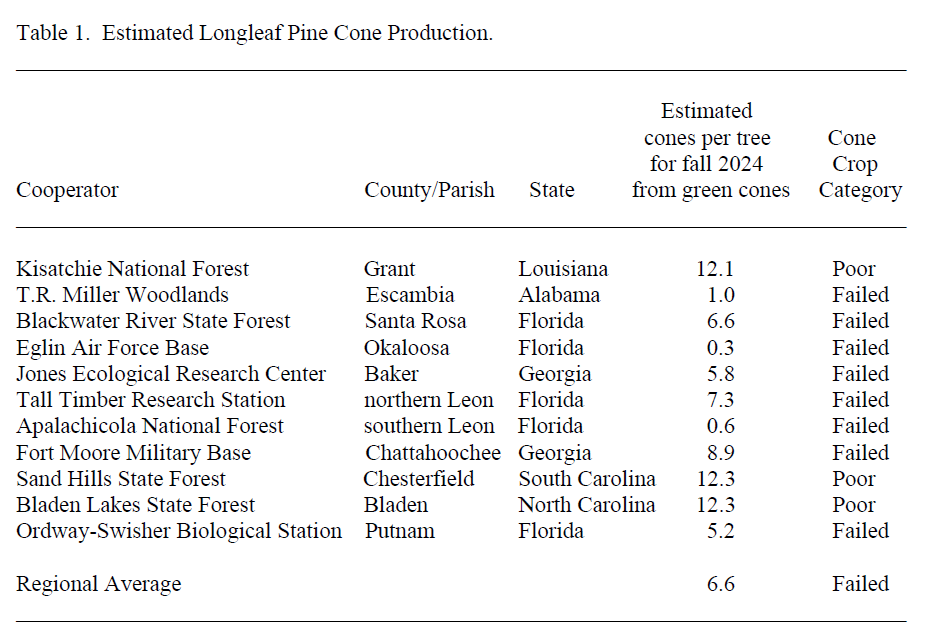Failed 2024 Crop – Longleaf Pine Cone Prospects
June 7, 2024
More so than other southern yellow pine species, longleaf pine cone production is variable, with infrequent good crops. The process is influenced by many environmental factors over the course of the cones' two-year development, with large differences observed from year to year and also from place to place.
Having an idea of upcoming cone crops helps longleaf growers plan for nursery seedling production and informs land managers' upcoming activities to promote natural regeneration, like prescribed burning or selective harvesting. The United States Forest Service and collaborators monitor longleaf pine cone production at 11 locations throughout the Southeast.
2024 Longleaf Cone Production
The regional cone crop, based on green cone counts, is FAILED for 2024, at 6.6 cones per tree.
Even in a bad year, there is usually a decent cone crop somewhere. If you are lucky enough to have mature longleaf, please assess what kind of cone production you may have this summer.
NO bumper (>100 cones per tree), good (50 to 99 cones per tree), or poor (25 to 40 cones per tree) crops were observed at any of the sample locations.
A poor crop (10 to 24 cones per tree) is present at 3 sample sites: Grant Parish, Louisiana; Chesterfield County, South Carolina; and Bladen County, North Carolina.
A failed crop (<10 cones per tree) is present at 8 sample sites: Escambia County, Alabama; Santa Rosa County, Florida; Okaloosa County, Florida; Baker County, Georgia; Leon County, Florida; Chattahoochee County, Georgia; and Putnam County, Florida

The natural variation of longleaf pine cone production means that even when crops are forecast to be low, some stands may produce an abundance of cones.
The best way to know the status on cone production for your particular property is to visually estimate cone production yourself. Instructions and a data collection sheet can be found in the 2024 Cone Prospects Report.
Limited Seed Supply for 2025 Seedlings
The 2024 report indicates that seed supply will become limited for next year's seedlings. Landowners with fair or better cone crops may have a potential income opportunity if their longleaf stands are large enough and easily operable (low density with machine access for collection).
TLA can help connect good sites with those specialists seeking places to harvest. Reach out at longleafalliance.org/contact or email Ad Platt at ad@longleafalliance.org.
Longleaf Pine Seed Production & Germination
+ From strobili to pollination to fertilization to viable seed, the seeds contained in this year's longleaf pine cones have been over 2 years in the making.
+ Longleaf seed is larger and heavier than other southern pines. It does not disperse far from the parent tree.
+ Longleaf pine cones release seed in the fall, and the seed will germinate just a couple weeks after falling to the ground. You’ll often see new germinants with the seed/wing still attached.
+ Cone collection for longleaf pine seed harvesting occurs when the cones are mature to ensure maximum viability.






